Ignacio Zuloaga
Ignacio Zuloaga y Zabaleta (July 26, 1870 – October 31, 1945) was a Spanish painter, born in Eibar (Guipuzcoa), near the monastery of Loyola.
Ignacio Zuloaga | |
|---|---|
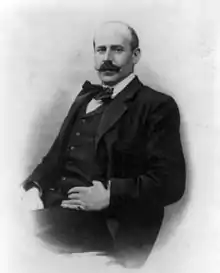 Ignacio Zuloaga in 1909 | |
| Born | Ignacio Zuloaga y Zabaleta July 26, 1870 |
| Died | October 31, 1945 (aged 75) |
| Nationality | Spanish |
| Known for | Painting |
Family
He was the son of metalworker and damascener Plácido Zuloaga and grandson of the organizer and director of the royal armoury (Don Eusebio) in Madrid. His uncle was Daniel Zuloaga.[1] His great-grandfather who was also the royal armourer was a friend and contemporary of Goya.[2]
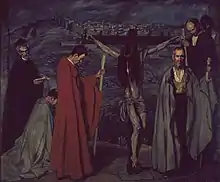
Biography
In his youth, he drew and worked in the armourer's workshop of his father, Plácido.[3] His father's craftmanship, a familial trade, was highly respected throughout Europe, but he intended his son for either commerce, engineering, or architecture, but during a short trip to Rome with his father, he decided to become a painter.[4] His first painting was exhibited in Paris in 1890.[5]
.jpg.webp)


At the age of 18 he moved to Paris, settling in Montmartre, to find work and training as a painter. He was nearly destitute, and lived off some meager contributions by his mother and the benevolence of fellow Spaniards, including Paco Durrio, Pablo Uranga, and Santiago Rusiñol.[6]
After only six months' work he completed his first picture, which was exhibited at the Paris Salon of 1890. Continuing his studies in Paris, where he lived for five years, he was in contact with post-impressionists such as Ramon Casas, Gauguin and Toulouse-Lautrec, yet his tendencies were always to a thematic that was more ethnic in scope.
He attempted to gain success during a sojourn in London; but lackluster patronage led him to return to Spain, settling in Seville, then Segovia, and developed a style based on a realist Spanish tradition, recalling Velázquez and Murillo in their earthy colouring and genre themes. He painted portraits of attired bullfighters and flamenco dancers; or portraits of family members and friends in such attire. He also painted village dwarves (El enano Gregorio el Botero; Hermitage, St Petersburg, Russia) and beggars, often as stark figures in a dreary landscape with a traditional landscape or town in the background. He also painted some village-scape scenes.[7] He favored earth or muted tones, including maroon, black, and grey, with the exception of colorful folk attire or the bright red cassock in some paintings.
Zuloaga married Valentine Dethomas on May 18, 1899. Valentine's brother, Maxime Dethomas, was a fellow student of Zuloaga in Paris.
Zuloaga and his patrons felt slighted in 1900, when his painting Before the Bull-fight was rejected for inclusion into the Spanish representation at the Universal Exposition in Brussels. In 1899, one of his paintings exhibited in Paris had been purchased for the Luxembourg Palace. However, he did exhibit the painting at the Exposition of the Libre Esthetique in Brussels, and did see it acquired by the Modern Gallery in Brussels. He was accepted into the Venice Biennale in 1901 and 1903,[8] and displayed 34 canvases at the Barcelona International exposition of 1907.[9]
Among one of the more prominently displayed works is his Cristo de la Sangre (Christ of the Blood) or Hermandad del Cristo Crucificado (Brotherhood of the Crucified Christ), on display at the Museo Reina Sofia in Madrid. He also painted a similarly painting of individuals undergoing a traditional mortification of the flesh and a bleeding crucified Christ called The Flagellants (1900). These paintings were praised by Unamuno in his book on De Arte Pictorico as being honest representation of Spain: a Spain religious and tragic, a black Spain.[10] rooted in the particularly Spanish Catholic fascination with mutilating penance.
Brinton in his review of an exposition in America in 1909, he states that:
It is this racy and picturesque life which Zuloaga seeks above all else to place on record, and it is these popular types unspoiled by ruthless modernism which he pursues into the farthest corners of his native land. In this zealous quest of congenial models he hesitates at nothing. He will haunt for hours a fiesta on the outskirts of some provincial town, or hasten away to the mountains, passing months at a time with smugglers and muleteers, with the superstitious fanatics of Anso in the extreme north of Aragon or with the monkish cutthroats of Las Baluecas, a little village on the southern boundary line of Salamanca.[11]
Gil says that the faces of the old folk he paints are
severe, roughly mystical, beset by painful thoughts, shadowed by the remembrance of the glory they once were, they have sad souls, moaning under the weight of an ideal of centuries, they are not individual representations, but the synthesis of the sadness of the Spanish Soul.[12]
One of the American collections to feature Zuloaga's work is the Johns Hopkins University's Evergreen Museum & Library, Baltimore, Maryland. Officially owned by the Evergreen House Foundation, an independent entity started by Zuloaga's great friend, philanthropist Alice Warder Garrett (1877–1952), Evergreen's works include full-length portraits of Mrs. Garrett (1915; 1928); a seated portrait of Ambassador John Work Garrett (1872–1942); a Spanish landscape; a painting based on the opera Goyescas; and a landscape of Calatayud (Spain).
An Iberia airline Airbus A340-642 aircraft, registration EC-IZY, is named after him.
Zuloaga during and after the Spanish Civil War
Zuloaga was committed to the Nationalist faction during the Spanish Civil War and the Spanish State of the caudillo Franco, whose portrait he painted in 1940. During the war, Zuloaga honored the defenders of the Siege of the Alcázar in 1936, when the building's Nationalist defenders refused to surrender despite the building being in flames. This siege, and other events such as the death of General Moscardo's son, served as a rallying cry for the Nationalist forces. In January 1939, this painting was hung in adjacent room displaying Picasso's modernist painting of Guernica during an exhibition of Spanish art in London.[13] The nationalist content of his depiction of the Alcazar was allied to Zuloaga's celebration of folk traditions. Stylistically, the directness of the Siege painting also avoids modernity's challenge to realistic depictions: Fascism was not endeared to complex symbolism such as found in works such as Guernica.
In an April 1939 letter to his patron, Mrs Garret, Zuloaga stated:
Thanks to God, and to Franco, at last the war is won and over! And over, despite the goodwill of those so-called democratic countries – what a farce, what shame, when those countries learn the truth of this drama! We all will work with all our strength to rebuild a new Spain (free, great and unified) to Spanishize Spain, and get rid of all outside influences, so that we can keep our great nature. That’s my dream in art. I hate fads (which are destructive to racial characteristics) One must (for good or bad) be oneself, and not ape the style of anyone else. I will dedicate the years that are left to me to that end. What shame there will be in the future, for those countries who inflicted crime, savage vandalism, which reigned within the soviet clan in Spain![14]
He was later to claim that he was aghast, as a francophile, when Hitler defeated France in 1940. After his death in 1945, he appeared on Spain's 500 peseta banknote emitted by Francoist Spain in its 1954 series, with a depiction of Toledo on the back.[15]
Brinton in his 1909 essay was prescient of Zuloaga's future enamourment with Falangism:
He personifies in extreme form the spirit of autocracy in art, the principle of absolutism so typical of his race and country. You will meet in these bold, affirmative canvases no hint of cowardice or compromise. The work is defiant, almost despotic. It does not strive to enlist sympathy nor does it fear to be frankly antipathetic...the tones not infrequently acidulous, and the surfaces sometimes hard and metallic. Reactionary if you will...[16]
Gallery
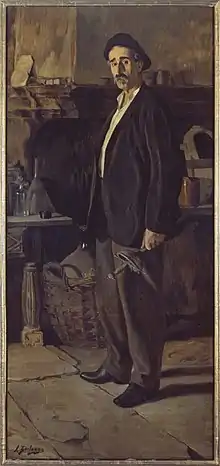 Don Plácido Zuloaga en su taller (1895), Madrid, Museo Nacional Centro de Arte Reina Sofía
Don Plácido Zuloaga en su taller (1895), Madrid, Museo Nacional Centro de Arte Reina Sofía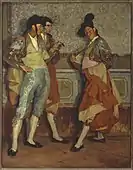 Torerillos de pueblo (1906), Madrid, Museo Nacional Centro de Arte Reina Sofía
Torerillos de pueblo (1906), Madrid, Museo Nacional Centro de Arte Reina Sofía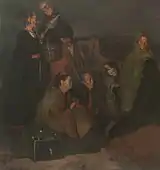 Las brujas de San Millán (1907)
Las brujas de San Millán (1907)_1909.jpg.webp) Juan de Azurmendi (1909)
Juan de Azurmendi (1909) Gitanilla (after 1910)
Gitanilla (after 1910) Portrait of Anita Ramírez in Black (ca. 1915), Brooklyn Museum
Portrait of Anita Ramírez in Black (ca. 1915), Brooklyn Museum
References
- Buffalo Fine Arts Academy (1909). Academy notes (Public domain ed.). The Academy. p. 156. Retrieved 11 September 2012.
- Brinton 1916, page 10
- Brinton 1916, page 11.
- Brinton 1916, page 12
- Utrillo in Five Essays, page 8.
- Brinton 1916, page 13
- Brinton 1916, page 16
- Esposizione Internazionale D'arte Della Città Di Venezia 1903, Catalogo Illustrato, Third Edition; Premiato Stabilimento Dottore Chappuis, Bologna, 1903. page 39.
- Brinton 1916, pages 19–20
- "Esta Espana religiosa y tragica esta Espana negra" quoted in Nancy Dean Faires (2007), This is Not a Museum: the Guggenheim Museum Bilbao.
- Brinton 1916.
- Padre M. Gil, En el Estudio de Zuloaga in Five Essays, page 98...."aquellos rostros de viejos y viejecitas, severos, rudamente místicos, preocupados por un pensamiento doloroso, ensombrecidos por el recuerdo de glorias que fueron, tienen el alma triste, gimen bajo el peso de un ideal de siglos, no son representaciones individuales, son la síntesis de la tristeza del alma española."
- Crosson, D. page 148.
- Crosson, page 151.
- 500 peseta
- Brinton 1909, page 30.
Further reading
 This article incorporates text from a publication now in the public domain: Chisholm, Hugh, ed. (1911). "Zuloaga, Ignacio". Encyclopædia Britannica (11th ed.). Cambridge University Press.
This article incorporates text from a publication now in the public domain: Chisholm, Hugh, ed. (1911). "Zuloaga, Ignacio". Encyclopædia Britannica (11th ed.). Cambridge University Press.- Brinton, Christian (1916). Foreword by John S. Sargent, Introduction notes and Bibliography by Christian Brinton. (ed.). Exhibition of Paintings by Ignacio Zuloaga under the auspices of Mrs Philip M Lydig. Second Impression. New York.: Redfield-Kendrick-Odell. Co.
- Brinton, Christian (1909). Catalogue of paintings by Ignacio Zuloaga exhibited by the Hispanic society March 21 to April 11, 1909. New York.: Hispanic Society of America.
- Hispanic Society of America (1909). Five essays on the art of Ignacio Zuloaga; Miguel Utrillo, Arsène Alexandre, Gabriel Mourey, René Maizeroy, and the Reverend Father M. Gil.. New York.: Hispanic Society of America.
- Thesis on Zuloaga by Dena Crosson (2009), University of Maryland.
- Artcult.com Zuloaga article
- Britannica on-line
External links
| Wikimedia Commons has media related to Ignacio Zuloaga. |
- Works by or about Ignacio Zuloaga at Internet Archive
- Ignacio Zuloaga Museum (es, en, eu)
